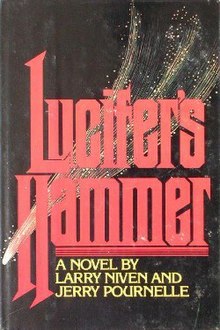Lucifer's Hammer
 First edition | |
| Author | Larry Niven Jerry Pournelle |
|---|---|
| Cover artist | Anthony Russo[1] |
| Country | United States |
| Language | English |
| Genre | Science fiction |
| Publisher | Del Rey |
Publication date | 1977 |
| Media type | Print (hardback & paperback) |
| Pages | 494 pp |
| ISBN | 0-87223-487-8 |
| OCLC | 2966712 |
| 813/.5/4 | |
| LC Class | PZ4.N734 Lu PS3564.I9 |
Lucifer's Hammer is a science fiction post-apocalypse-survival novel by American writers Larry Niven and Jerry Pournelle that was first published in 1977.[2] It was nominated for the Hugo Award for Best Novel in 1978.[3] Two issues of a planned six-part comic book adaptation were published by Innovation Comics in 1993.[4]
Plot summary[]
When wealthy soap company heir and amateur astronomer Tim Hamner co-discovers a new comet, dubbed Hamner-Brown, the documentary producer Harvey Randall persuades Hamner to have his family's company sponsor a television documentary series on the subject. Political lobbying by California Senator Arthur Jellison eventually gets a joint Apollo-Soyuz (docking with Skylab B) mission into space to study the comet, dubbed "The Hammer" by popular media, which is expected to pass close to the Earth.
Despite the scientific community repeatedly assuring the public that a collision with Earth is extremely unlikely, pieces of the comet's nucleus impact across the Western Hemisphere, with devastating results. The strikes on parts of Europe, Africa, the Gulf of Mexico, and the Pacific and Atlantic Oceans set off volcanoes, destabilize fault lines, including the San Andreas Fault, and cause tsunamis thousands of meters high, destroying major coastal cities around the world, killing billions and initiating long-term climate problems because of the massive quantities of vaporized seawater in the atmosphere.
Immediately after the strike, China, anticipating the coming ice age launches a preemptive nuclear attack on the Soviet Union. The last Soviet premier reassures the US that it is not the target, and he requests help against the unprovoked attack.
Jellison's ranch forms the center post of a fiefdom in the Sierra foothills, dubbed "the Stronghold," where he presides over a small population of survivors, including Randall and Hamner, who struggle to maintain civilization.
Shortwave radio, the only surviving means of mass communication, is eagerly monitored and reveals a chaotic situation after the Fall. Several people, including some who had been officials of the former US government, claim to be the new or currently acting US President, but others are now self-proclaimed monarchs of various regions or areas. Many people subsist by looting former stores and by catching rats and various fish, especially the now-plentiful giant carp, which are mostly either former pet goldfish or their progeny, engorged by the massive supply of food available to them, primarily in the form of human and animal corpses. Some advanced technical knowledge was maintained by the means of the preservation of a collection of books, which had been wrapped in impermeable plastic and submerged in a septic tank shortly after Hammerfall and later retrieved by a JPL scientist, who realized their potential value and likely scarcity in a post-Hammer world.
Reverend Henry Armitage manages to take control of a cannibalistic group of petty thieves and the remnants of a former US Army unit, integrating them into his pre-existing band of followers, the New Brotherhood Army. The Reverend's forces begin a rampage through the area, culminating in a series of battles with the inhabitants of the Stronghold. Jellison's force prevails with the help of chemical weapons, saving the Stronghold and also defending a nuclear power plant nearby, thus preserving a supply of electric power that is needed to rebuild civilization.
Literary significance and reception[]
Niven and Pournelle originally pitched the story to publishers as an alien invasion story in which the aliens drop a comet onto Earth after humanity fights them. Jim Baen told them to write only the comet story. The original story idea was later written as their novel Footfall.
Judith T. Yamamoto, in her review for the Library Journal, said that the novel was full of "good, solid science, a gigantic but well developed and coordinated cast of characters, and about a megaton of suspenseful excitement." Her one negative comment was that the pro-technology pitch might turn off some readers but "all in all it's a good book, if not a great one."[5] Lucifer's Hammer received a nomination for the Hugo Award for Best Novel in 1978.[3]
C. Ben Ostrander reviewed Lucifer's Hammer in The Space Gamer No. 13.[6] Ostrander commented that "I recommend this book.... Don't miss it for a long, interesting story."[6]
See also[]
- The Hammer of God, novel by Arthur C. Clarke about an asteroid strike.
- Seveneves by Neal Stephenson, in which the Moon disintegrates and falls to Earth as "Hard Rain".
- The Star by H.G. Wells, 1897 short story which can be considered the progenitor of thus SF sub-genre
References[]
- ^ "Lucifer's Hammer". ISFDB.
- ^ P. Curtis, Claire (2010). Postapocalyptic Fiction and the Social Contract: We'll Not Go Home Again. ISBN 9780739142059.
- ^ a b "1978 Award Winners & Nominees". Worlds Without End. Retrieved 2009-07-20.
- ^ "Lucifer's Hammer". Comic Vine.
- ^ Yamamoto, Judith T. (1977-07-01). "Lucifer's Hammer (Book Review)". Library Journal. 102 (13): 1528. ISSN 0363-0277.
- ^ a b Ostrander, C. Ben (September–October 1977). "Books". The Space Gamer. Metagaming (13): 32.
External links[]
- Lucifer's Hammer at Worlds Without End
- Lucifer's Hammer sample chapters from Baen Books (the Hot Fudge Sundae scene is in "April: One")
- Lucifer's Hammer title listing at the Internet Speculative Fiction Database
- American science fiction novels
- 1977 American novels
- 1977 science fiction novels
- American post-apocalyptic novels
- Fiction about comets
- Collaborative novels
- Novels by Larry Niven
- Novels by Jerry Pournelle
- Impact event novels
- Playboy Press books